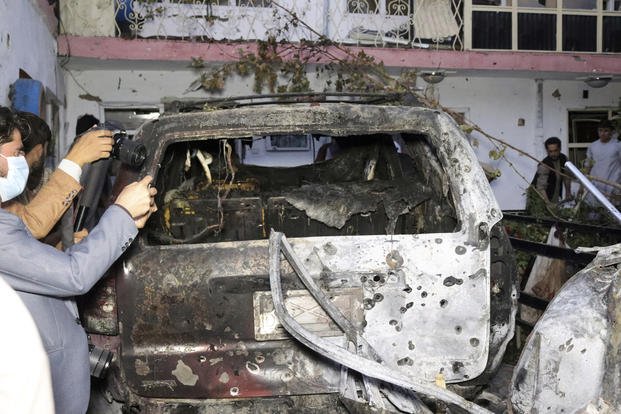A Defense Department review found that a U.S. airstrike in Kabul that killed 10 civilians during the chaotic final days of the Afghanistan war in August was the fault of poor intelligence and rushed decision-making, but it did not violate any laws.
"It's not criminal conduct or negligence," Air Force Lt. Gen. Sami Said, who led the review, told reporters Wednesday during a Pentagon press briefing, but was short on the specifics on how the airstrike failed. No enemy combatants were killed, and the deaths of innocent civilians marred the conclusion of a two-decade war.
Although the review found no criminal actions, those involved in the strike still can face disciplinary actions by their chain of command, Said said.
Read Next: Thousands of Airmen and Guardians Defy Services' Vaccine Order
On Aug. 29, the day before all U.S. forces pulled out of Afghanistan, the Pentagon was tracking multiple potential threats to Hamid Karzai International Airport -- where U.S. and allied forces were dug in and frantically trying to evacuate tens of thousands of Afghans after the Taliban swiftly took control of the country while facing little resistance.
One of those supposed threats was a white Toyota Corolla driven by Zemari Ahmadi, who worked for Nutrition & Education International, an aid organization. Drone operators and mission planners believed that the car was carrying explosives and that it was going to be used as a bomb at one of the airport's gates. They hit it with a Hellfire missile, killing three men, including Ahmadi, and seven children.
The Pentagon later admitted that the vehicle posed no threat, after originally claiming the missile impact triggered multiple explosions, suggesting the vehicle was equipped with bombs. Further investigation revealed no explosive payload.
Investigators interviewed 29 individuals, including 22 who were directly involved in the strike, operating out of Qatar at the time. They found no violation of any laws and mostly laid the blame on confirmation bias and a rushed timeline of several hours to gather intelligence, access to fewer intelligence assets in the country, and a chaotic urban environment that can make tracking and identifying potential targets more difficult than in more open rural areas. However, Said’s briefing on the investigation was short on specifics, due to the report itself being classified.
Pentagon officials have historically been reluctant to acknowledge civilian casualties tied to drone strikes, with official estimates varying widely from those produced by non-governmental groups. Former President Barack Obama issued an executive order in 2016 requiring the disclosure of very limited details about civilian casualties, an order that was reversed when former President Donald Trump took office.
A report from the Office of the Director of National Intelligence estimated that, between 2009 and 2015, drone strikes killed between 64 and 116 noncombatants in areas outside the war zones of Afghanistan, Iraq and Syria -- mostly referring to Pakistan and parts of Africa.
Data from the Bureau of Investigative Journalism -- a nonprofit organization based in London -- estimates that since 2015, between 300 and 900 civilians have been killed by airstrikes in Afghanistan. Most drone strikes in Afghanistan occurred in rural areas that were difficult to access by journalists or military investigators, meaning that often assessments of casualties were left to military analysts reviewing video footage without on-the-ground information, and human rights groups following up long after the strikes themselves.
The Aug. 29 strike was a marked departure from that pattern, in that the strike occurred in the country's largest city with many journalists nearby covering the final U.S. evacuation.
Immediately after the Aug. 29 strike, Army Maj. Gen. Hank Taylor, deputy director for regional operations and force management, told reporters that the vehicle was "known to be an imminent ISIS-K threat," saying the "self-defense strike" caused "significant secondary explosions" from the vehicle.
Chairman of the Joint Chiefs Gen. Mark Milley publicly described the bombing as a "righteous strike," before the Pentagon backtracked, admitting that only civilians had been killed.
The botched airstrike came three days after a devastating attack by ISIS-K suicide bombers that killed 13 U.S. troops and killed and wounded scores of Afghan civilians, marking one of the bloodiest days of the war.
"You have to put yourself in the conditions at the time," Said urged, highlighting that chaotic environment and the fog of war.
Said did not recommend that any individuals involved in the strike be disciplined, saying he found an "aggregate process breakdown." However, he said the chain of command still can take action, which could include firing or demoting those involved.
When asked who gave the final approval for the strike, Said named Maj. Gen. Christopher Donahue, who was the commander of the forces on the ground at the time and serves as commanding general of the 82nd Airborne Division at Fort Bragg, North Carolina.
-- Steve Beynon can be reached at Steve.Beynon@military.com. Follow him on Twitter @StevenBeynon.
Related: House Votes to Award Congressional Gold Medal to Troops Killed in Kabul Airport Blast











